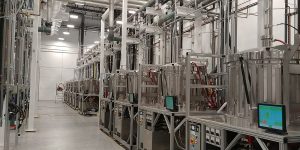Shop-Vacs although “handy”, have limited capability in an industrial environment.

View of kiln room
SysTech assisted with equipment design and supply of central vacuum system components for a Philadelphia, PA based manufacturer of circuit board backing material, used in smartphones and tablets. Due to high demand, the manufacturer needed to increase its production capacity to maintain contracts with OEM manufacturers including Apple, Microsoft, and Samsung.
The manufacturer uses high temperature kilns to bake a proprietary blend of materials, including silicone and graphite, into a circuit board backing material. Each circuit board is configured in a designated mold. The kilns are small, housing a few pounds of mold material and require individual care. This care includes housekeeping within and around the kilns once baking of the materials has finished. During the heating process, the graphite blend expands within the molds and the overflow settles on the lower levels of the kiln. The waste material is a grainy particulate that is difficult to clean up manually. Stringent quality control of the process requires any waste material be properly collected and sent to waste for disposal.
The project went through a series of starts and stops, ending in an accelerated delivery schedule. The design phase was in quarters one and two. Once the design had been established, a formal request for submittals of all equipment was required, and the approval process commenced. Due to the high monetary value associated with the final product, approvals were fast tracked; SysTech expediting the equipment manufactures’ normal process delivery schedules to coincide with the customer’s schedule.
SysTech planned the filtration, explosion and electrical systems per the engineer’s design requirements. The basic premise of the new cleaning system was for the end user to have a central vacuum system, instead of individual vacuum units. This enabled the manufacturer to exceed all necessary quality control housekeeping protocols set forth by their customers and adhere to explosion safety precautions. In addition, the customer wanted to automate the cleaning system as much as possible, doing away completely with lost productivity caused by portable vacuums breaking down or needing to be cleaned. Their Shop-Vacs could not comply with these important requirements.
The kilns were laid out in 10 rows, of four (4) kilns, each located within a 15’ x 15’ block. With SysTech’s guidance, a single central use point was located at the center of each block. From there, a 25’ hose with crevice tool was used by the operator to service four (4) separate kilns. The industrial vacuum system was laid out to accommodate three (3) simultaneous users – with a total of forty (40) individual drops. (The system design was based on a future of eighty (80) drops.) The furthest pick-up point was over 300’ from the blower, which was located remotely on an equipment mezzanine.
Industrial Vacuum System Design
A Donaldson Torit TD-182 cartridge collector was selected with a vacuum rating of 16’’ HG, to withstand the draw from the National Turbine Multistage Exhauster that comprised the “engine” of the system. The multistage exhauster was selected for 400 ICFM at 10’’ HG to account for the static loss of the system components and included a solenoid-actuated surge valve to remove a ‘dead head’ situation if all users closed their vacuum ports simultaneously. While the Donaldson Ultra-Web filters in the collector have a particulate removal rate of 99.99% down to 0.33 micron, the system discharges indoors, and a Flanders stainless steel bag-in bag-out HEPA filter was installed to protect the exhauster and for safe practices.

Donaldson Torit TD-182, airlock, HEPA filter housing and control panel
A safety protocol was instituted due to the combustibility of the graphite material. Following proper National Fire Protection Association (NFPA) codes applicable standards; the system included an IEP Technologies explosion protection system comprised of full chemical suppression coupled with inlet and outlet chemical isolation. The system was governed by a rate of rise pressure detection system – an IEP Technologies proprietary design. The rate of rise component allows for an explosion to be detected and suppressed with less likelihood of false actuations. The ability of the MEX-3 to analyze rate of pressure rise, and to differentiate this from non-explosion pressure excursions, sets it apart from other solid-state explosion pressure sensors. The MEX-3 is programmable to accommodate a wide range of hazard and process conditions, including vacuum and positive pressure applications. Additionally, the detector design is suitable for hygienic applications.
Additional NFPA compliance included a Prater rotary airlock at the hopper discharge required to meet NFPA 68 and 69.
For controlling the system, a custom control panel was built to house controls for all the system operating components. The multi-stage exhauster, collector, HEPA, Prater Rotary Airlock and the IEP explosion suppression system were all governed by a single point control panel. The panel also included a PLC to control the forty (40) “points of use” hose connector flap switches, that when opened, sent a signal to the control panel to start the multi-stage exhauster. A Cutler-Hammer Variable Frequency Drive linked to the exhauster motor was programmed to reach three (3) tiers of set points for required airflow. As additional users plugged into their ports, the system would automatically sense the additional gate opening and increase the blower speed to maintain proper airflow within the system. This feature allowed a fully autonomous system that did not require on/off switches or multiple trips to the central panel.
The system is in full operation with clean kilns meeting necessary quality control and safety criteria. If your vacuum system isn’t up to par, call us at 800-456-9460 or visit www.systechdesign.com for more information on creating a system that works to design capacity when you need it.

The complete explosion protected vacuum system


